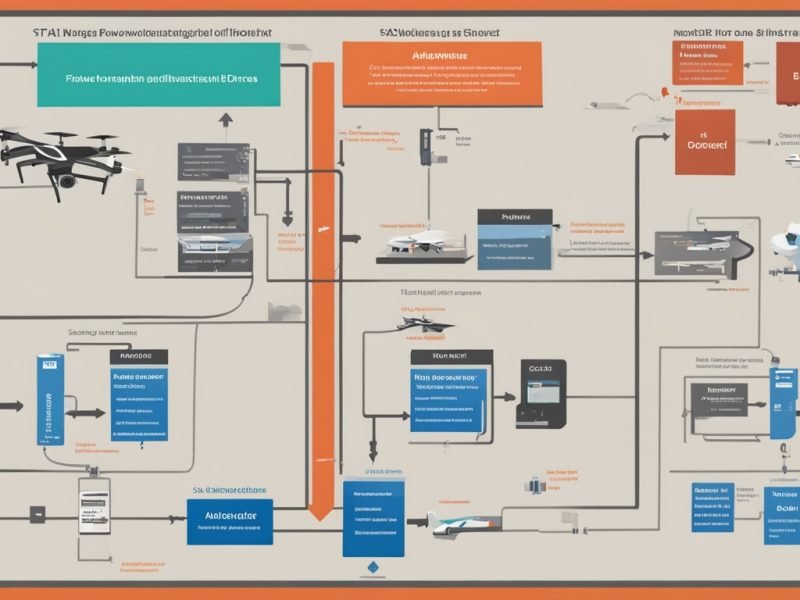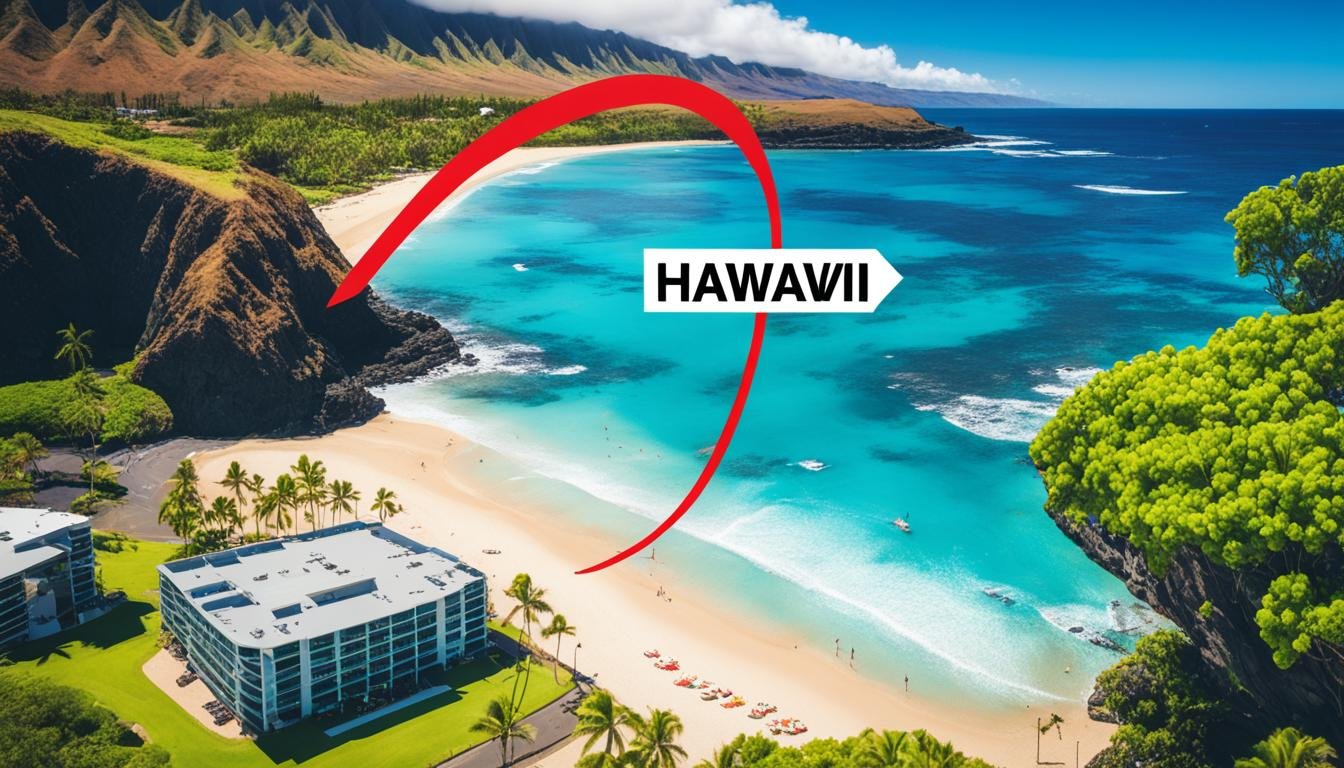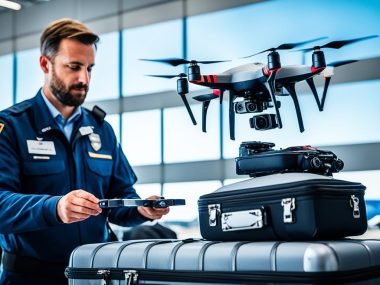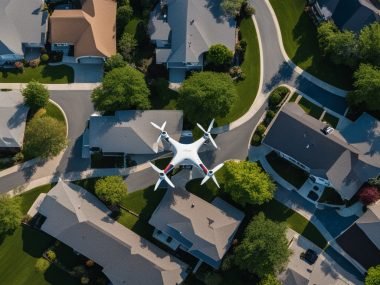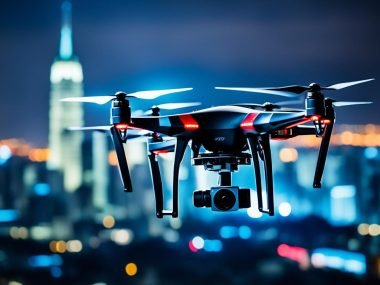Imagine this: by 2020, about 7 million drones could be flying in the sky. This number comes from a prediction by the Federal Aviation Administration. With so many drones, you might think if they can easily pass through TSA checks in our bags. The answer to “Are Drones Allowed Through TSA?” is not so simple. While the sky is vast, the TSA has strict rules on the ground for drones.
Before you head to the airport, you need to make sure your drone follows TSA rules. Drone checks are now common at airports. Yet, taking drones on planes needs you to follow certain steps. This is because there are strict rules to follow.
Key Takeaways
- TSA permits drones to pass through security checkpoints, but airline policies may vary.
- Take heed of FAA regulations for drones with lithium batteries, as they could impact your ability to bring them in luggage.
- Always check the TSA’s ‘What Can I Bring?’ page for up-to-date information on drone transportation.
- Drone security screening might require the device to power up, following similar protocols as other electronics.
- The TSA holds the final authority on whether a drone can pass through, so prepare for a detailed review at the checkpoint.
Understanding TSA Drone Policy
For aerial enthusiasts or pros, knowing the TSA drone policy is crucial. If I’m traveling with a drone, I make sure it meets drone carry-on restrictions. It also needs to follow drone regulations. These rules outline what’s okay for taking drones through airport security. Remember, these don’t replace the airlines’ own rules.
The tech inside drones, like lithium batteries, needs special attention due to FAA rules. Drones with these batteries need to be packed carefully. I check FAA limits to prevent issues during security checks. If you find this complex, see my table for a quick guide:
| Component | TSA Considerations | FAA Restrictions | Airline Policy Variances |
|---|---|---|---|
| Lithium Batteries | Allowed in carry-on, check for specifics | Limits on watt-hour rating | Varies, some airlines have tighter restrictions |
| Fuel Cells | Special handling required | Restrictions on carriage and usage | Different allowances per airline |
| Parachute Systems | Subject to inspection | Regulated based on deployment mechanism | Approval required from some carriers |
At TSA checks, I remember my drone may need a power test. Devices that won’t turn on can’t board. This rule keeps all passengers safe. Making sure my drone is ready helps everything go smoothly.
The TSA drone policy lets us take drones on planes. But, it means we must know all drone carry-on restrictions and drone regulations. It’s our job, along with TSA and airlines, to ensure safe travel. Knowing these rules well means I can travel without worries, drone in hand.
Preparing Your Drone for TSA Security Screening
Traveling with drones makes capturing memories from above more exciting. But, you must think ahead. Preparing your drone for TSA security screening is key to a smooth journey. I’ll guide you through important steps to ensure you and your drone reach your destination safely.
Check the Airline’s Drone Regulations
Before packing, it’s vital to check the airline’s rules for drones. Since each airline might have different policies, knowing yours is crucial. This not only ensures compliance but also protects your equipment from damage or inconvenience.
Packing Drones with Lithium Batteries
Lithium batteries in drones need special care. They often can’t go in checked luggage due to FAA rules. It’s safer to carry them in your carry-on. This avoids the risk of temperature extremes. Always protect each battery to avoid short circuits. Use a clear plastic bag or a protective sleeve.
Additional Screening for Electronic Devices
Be prepared for extra steps at TSA security. Drones might get more scrutiny. TSA may ask you to turn on your devices to check them. Ensure your drone is charged and easy to access. This minor inconvenience ensures safety for all in the skies.
Keeping these points in mind will help you focus on capturing amazing aerial photos. You’ll worry less about the logistics of getting there.
Drone Carry-On Restrictions
I love drones and always make sure I know the drone carry-on restrictions when I travel. I’ve learned a lot about drone security screening and TSA drone rules. The first thing to do is check with your airline. This makes sure your drone fits their carry-on rules. It’s important because of the drone’s size and the kind of batteries it has.
I’m careful about the lithium batteries in my drone. We must follow FAA rules about these batteries. If we don’t, the TSA might not let our drones through at checkpoints.
I make a checklist of what’s needed based on my drone and the rules from airlines and TSA. This includes size, battery types, and any extra parts. I check everything before I go to the airport.
Here’s a simple table that shows what you need for drone carry-on:
| Drone Specification | Airline Policy | FAA Regulation | TSA Screening |
|---|---|---|---|
| Dimensions | Must fit in overhead bin or under seat | N/A | Subject to physical inspection |
| Battery Type | Usually allows lithium batteries | 100Wh limit without approval | May require removal and separate screening |
| Weight | Adheres to carry-on weight limits | N/A | Heavier drones may need additional screening |
| Additional Components | Approval needed for unusual accessories | Must comply with hazardous materials regulations | May be subject to enhanced screening |
Knowing these things makes it easy to go through security with my drone. For a smooth trip, being ready is key. Following TSA drone rules helps avoid problems at the airport.
The TSA gives basic rules for flying with drones. But the security officers make the final call. That’s why I always make sure I’m up to date on drone carry-on restrictions for each trip.
TSA’s Final Say in Drone Transportation
When flying with drones, remember the TSA officer has the final say. Even if you follow all rules, they decide if your drone flies with you. Sometimes, they might need to check your drone more closely. This can happen if they see a security risk.
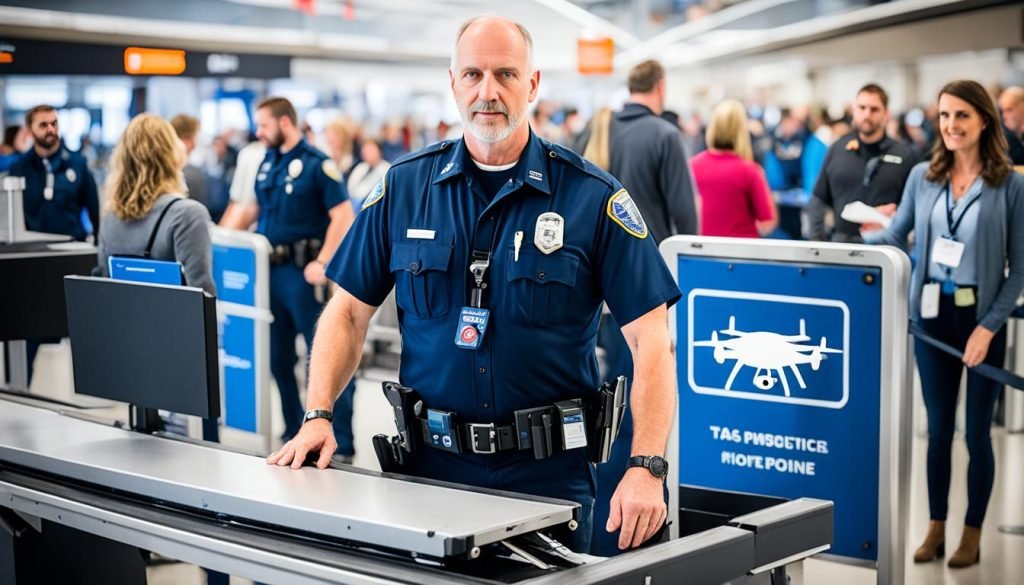
Item-Specific Decisions at the Checkpoint
I always prepare for the TSA’s item-specific decisions at airports. A drone might set off an alarm or look like it’s been altered. While drones are usually okay to bring, these issues can cause extra checks. They might even stop you from bringing it on board.
Powering Up Devices for Security Checks
Powering up devices is a key step. TSA officers may ask to turn on your drone. This shows it works. If your drone won’t power on, you can’t take it through.
Knowing TSA rules helps make flying with drones easier. Being ready for checks makes the experience smoother. Knowing what the TSA officer does is key for travelers.
| Checkpoint Consideration | Action Required | Potential Outcome |
|---|---|---|
| Alarm Triggered by Drone | Additional Screening | Clearance or Denial |
| Drone Appears Tampered With | Further Inspection | Possible Exclusion |
| Drone Fails to Power Up | Cannot be Transported on Plane | Denied Boarding |
Flying with Drones: Tips for a Smooth Journey
Are you eager to capture stunning aerial views or explore the skies? I get it, during with drones is thrilling. Yet, it’s crucial to pack and prepare your drones right for a worry-free trip. Here, we’ll dive into useful tips for transporting drones on planes.
Flying with drones doesn’t have to be complicated if you understand the rules and prepare accordingly.
First off, it’s key to keep up with TSA and FAA rules when packing your drone. Since these guidelines often change, checking the latest rules before you fly is wise. Focusing on batteries, especially lithium ones, is vital due to their fire risks. Packing them in fireproof cases is a smart move. It secures your gear and your peace of mind.
Planning for extra screening at the airport is another step I take when flying with drones. This helps me avoid any unexpected hiccups. A top tip: always charge your drone batteries. And be ready to show that your drone can power up. If it doesn’t turn on, it might stay behind.
Check out this table for essential drone travel tips:
| Travel Step | Preparation Recommendation | Benefits |
|---|---|---|
| Review Rules & Regulations | Check TSA, FAA, and airline policies on drones and batteries. | Ensures compliance and reduces risk of delays. |
| Drone Packing | Use dedicated drone cases; pack batteries in fireproof containers. | Protects equipment and adheres to safety guidelines. |
| Battery Preparation | Fully charge batteries; be prepared for device inspection. | Avoids power-related delays during security checks. |
| Plan for Additional Screening | Allocate extra time for security; organize drone accessories for x-ray screening. | Minimizes the chance of missing flights due to extended checks. |
Remember, flying with drones can greatly enhance your travel. But, it demands following the rules and careful packing. I find the effort totally worth it for the amazing views and unique shots from above. With your drone by your side, you’re in for a great adventure!
Transporting Drones on Planes: A Guide
Taking a drone on a trip means you must know and follow FAA drone regulations. These rules make sure everyone on the plane is safe. They are specific about how to carry and manage drones. As a keen aerial photographer and tech fan, I have learned these rules well. I want to make your next trip smoother.
FAA Regulations Impacting Drone Travel
I make it a point to know the FAA’s rules about battery handling and where to place my drone. Drones have lithium batteries that can be a fire hazard. This is why the FAA drone regulations are strict. They say that extra batteries must only be in your hand luggage. Make sure the battery ends are covered to stop short circuits.
Special Considerations for Drones in Checked Luggage
There are important tips for putting your drone in checked luggage with drones. It’s crucial that your drone is off, and parts that move are fixed well. This lowers the chance of it getting broken. You should also tell the airline about your drone. This way, they can handle your bag with care.
| FAA Regulation | Description | Impact on Travel |
|---|---|---|
| Lithium Battery Restrictions | Batteries must be in carry-on baggage. | Ensures the safety of passengers by preventing potential in-flight hazards. |
| Drone Deactivation | Drones should be powered off, with batteries secured. | Prevents unintentional activation or drone operation during transport. |
| Physical Protection | Proper cushioning and terminal coverings are required. | Reduces the likelihood of physical or electrical damage to drone components. |
I often travel with drones and staying up to date is key. Making sure your drone matches the drone travel guide advice helps a lot. It will make your time at the airport easier. Plus, it keeps your drone safe during your journey.
Are Drones Allowed Through TSA? What Travelers Need to Know
Many people who love aerial photography or flying drones wonder about the TSA drone policy. It’s good news that the TSA lets drones through security checks, but there’s more to consider. Understanding the drone security screening measures as well as transporting drones on planes is crucial for drone fans like me.
Good preparation is key to fly trouble-free. Before going to the airport, I always make sure to check the airline’s rules. Each airline has its own rules, along with TSA’s. Also, drone batteries, usually lithium, need extra attention because they can catch fire. I ensure my drone’s batteries meet both TSA and FAA rules.
- Review your drone’s power source, especially if it includes lithium batteries
- Carry on your drone if possible to avoid damage from rough handling
- Prepare for possible additional screening by fully charging your drone
| Component | TSA Screening | FAA Regulation | Airline Policy |
|---|---|---|---|
| Lithium Batteries | Check for damage or tampering | Limited quantity allowed in carry-on | Varies, usually aligned with FAA |
| Drone (size) | Fits within standard hand luggage dimensions | Not specified | Size restrictions may apply |
| Drone (power) | Must be capable of powering up | Must be able to disable or protect from activation | May need to show functionality |
Knowing all the rules for my equipment ensures a smooth trip. Being well-informed helps me pack right and feel sure at security checks. This way, I focus less on security stress and more on the exciting views I’ll capture.
Travel Experiences with Drones: Real Passenger Stories
As a drone enthusiast and frequent traveler, I’ve found that stories from real passengers are full of wisdom. They teach us how to fly with drones. Capturing stunning photos and bringing drones for work shows how these stories guide us. They help us know what to do at the TSA.
Successful Drone Transits
I have had great experiences with TSA workers. They liked how small my drone was and how well I packed it. Others have told me similar stories. They followed the rules closely and prepared well, making security checks easy.
They also mention the importance of handling lithium batteries right. Keeping them in clear cases and knowing the latest rules is key. Thanks to these steps, many enjoy smooth trips and capture beautiful shots at their destinations.
Challenges and Solutions
But, even experienced travelers sometimes face problems. Issues like extra screenings can happen because of our drones’ tech or batteries. And sometimes, airline rules can be confusing.
Stories I’ve heard show how crucial it is to have documents for your drone. Being ready to show how it works can also help. Facing these problems gets easier with good preparation and knowing TSA and airline rules.

